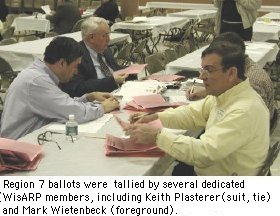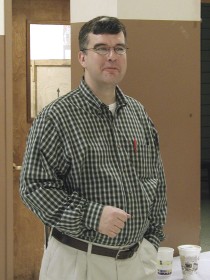Return to KenRail home page
Trains a keystone in metropolitan infrastructure
Annual meetings about improving train travel in the Midwest are a virtual rite of Spring, and in 2004 a significant event was hosted by NARP Region 7 and Midwest High Speed Rail Coalition in Chicago, within walking distance of two principal train stations and CTA 'El' trains. CTA buses laid over at a regular transfer point across the street from the IBEW meeting hall on Washington Boulevard.
No real world setting could better accentuate a modestly attended session featuring speakers describing train service in Mid-America, impediments to its improvement, examples elsewhere of successful "mode" integration, and ambitions of a nearby Indiana city for integrating its airport into the mix of travel modes with a rail connection to downtown Chicago. A rail connection to the central business district sustained for more than a century by elevated "heavy rail" trains, by commuter trains, by intercity travelers riding trains to and from Chicago Union Station, LaSalle Street Station, Northwestern Station, and Randolph Street Station.
| West Coast cities see Intermodal future North East cities live Intermodal "...all part of the same mobility." Even as a dedicated crew of Midwesterners spent a Saturday in March, 2004 hearing how and why one component in the metropolitan puzzle – train travel – is vital to overall urban function, one West Coast metropolis was learning from experts elsewhere in the West. Los Angeles County Mass Transit Authority chief of planning and development Jim de la Loza and Utah Transit Authority (Salt Lake City) chief capital development officer Michael Allegra observed that metro Seattle regional population densities and travel patterns are prime for high-capacity transit in combination with ongoing improvements for highways and buses. "It's not highways versus transit," Jim de la Loza said. "It's all part of the same mobility," he explained, according to Seattle Post-Intelligencer as his trio of experts completed three days evaluating Puget Sound transit and freeway usage. On the opposite seaboard, population and travel corridors have long warranted high capacity travel infrastructure, so airports dot the extended region with trains, buses and ferries interconnecting more under auspices of the 1991 Intermodal Surface Transportation Act (ISTEA). Train travel among the metropoli is the most advanced of any multi-state American region, a "North East Corridor" owned and operated by Amtrak at speeds up to 150 mph. Alas, even that maximum, 30 mph less than French TGVs and other nations' "high speed rail," is mostly a hope rather than a reality as Congress annually belittles Amtrak, under-funds it grossly and generally ignores America's increasingly vast lag behind transportation integration of other G-7 nations. |
As prelude to the day's emphasis on trains fitting into an overall system of travel "modes," National Association of Railroad Passengers and its Illinois ARP counterpart held a business meeting which ranged over several topics:
|
|||
 |
||||
Amtrak government affairs director Ray Lang led off the speaking sequence, accompanied by Marc Magliari, both based in Chicago. Typifying the refreshed attention to proven railroad practices that David Gunn brought with him from retirement almost two years ago, Mr. Lang was introduced right 'on the advertised' at 10:00 a.m. He recounted the budget squeeze Amtrak has regularly endured, and will again in FY2005 if the Bush Administration's proposal of $900 million is embraced by Congress. (Subsequently, Congress recessed April 2 after passing separate House and Senate Transportation budgets for FY2005, which must resolve in conference. Amtrak funding at $0.9 billion is 80 percent of the total DOT requests for the Federal Railroad Administration.) Questions to Mr. Lang ranged widely, from wonderment about expediting passage through Customs for International passengers at the Ontario-Michigan border to mention of the suburban Indianapolis car shops at Beech Grove. Mister Magliari elaborated on the imminent end to the International, which will become a Port Huron-Chicago train named the Blue Water. Schedule incompatibilities rather than uncertain delays at the Canadian border motivate the change, he explained, and the new daylight Blue Water will afford connections at Chicago which the International cannot fulfill. Reaching Beech Grove from Chicago entails a day of travel each way for each coach across track which is far less caliber than Amtrak typically uses.
On the positive side, several states, including Wisconsin and Michigan, responded to a cash crunch Amtrak faced with reinforced support for corridor trains; for Hiawathas in Wisconsin's case. Michigan is on course to qualify under FRA standards for reaching Class 6 speeds. (But see also the sidebar about Michigan's dilemma as it also seems to bow to train opponents.) Even so, another question about increased maximum speed affecting ridership and fare revenue evoked explanation that several trains each day operating at competitive speed yield well in revenues; that might be paraphrased by saying simply raising maximum speed to 90- or 110-mph is in itself not sufficient in cost-benefit terms, but slowing to longer enroute time than highway and/or air travel is also detrimental.
Shifting emphasis to the broader issues surrounding urban, metropolitan and intercity train services, Scott Bernstein, president of the Center for Neighborhood Technology, contrasted American household spending for travel with western European households, which spend about half as much as the 20-25 percent per-household spent on average by Americans.
| Mister Bernstein also noted domstic air travel continues in flux as carriers buy lighter aircraft which reduce landing fees, impacting the revenue streams airport operators depend on for covering expenses. Expenses which do not diminish merely because smaller planes carry fewer passengers and weigh less. Consequently, dwindling revenues for airports are causing operators to rethink their expansion planning, opening the way for rail access. He estimated 30 principal American airports have at least conceptual plans for rail access to air terminals, such as CTA 'El' trains already provide to O'Hare and Midway, and as established in 2003 at Newark with AirTrain General de Gaulle Airport.near Paris provides access to 180-mph TGV trains "one escalator away." At Frankfurt, Bahn riders flying with Lufthansa pay a combined rail-and-air fare which reflects synergies achieved by integration of the two travel "modes." |
How far backward can Midwest step? One of two states with track already suited for 110-mph passenger trains is embroiled in its Legislature over Senate Bill 267, according to National Assoc'n of Railroad Passengers. Michigan enjoys an advanced track structure owned by Amtrak which has hosted research into next-generation signalling, a necessity for increased high speeds. But at the behest of lobbying by other travel modes, Michigan legislators have – at least temporarily – inserted their august role into the nitty-gritty realm of fare-setting. Once the domain of state and federal regulators, pricing of transportation services – the merest tip of the capital infrastructure iceberg necessary to provide those services – has reverted to the 19th century model of market melee´ backed by randomly official intervention. Michigan legislators entanglement in pricing intricacies replicates the hopeless quandaries of 130 years ago, as government was solicited by railroad entrepreneurs and badgered by outraged constituents. Eventually, all factions agreed, sometimes tacitly, that expertise rather than lobbying clout should set revenue priorities – and the Interstate Commerce Commission was born, matched at state level by similar regulatory arbiters steeped in transportation expertise. |
||
The ever-thorny issues related to paying for infrastructure changes and upgrades needed to achieve comparable mode integration at American airports occupied his attention next, with familiar suggestions like a fuel tax, issuing bonds, or establishing a lottery obligating its 'take' to transit investment. Perhaps, he mused, the Air Transportation Stabilization Board created after September 11 might transform into simply a Transportation Stabilization Board for all modes – air, rail, bus, waterway ferry. By whatever avenue, he pointed out, the economies foreseeable from integrating travel modes in America should handily offset upfront capital investment.
 Executive director Richard Harnish (pictured at left) has worked diligently for a Midwest array of routes capable of sustaining 100 mile per hour-plus passenger trains. Arising from a nucleus of dedicated passenger train proponents who began meeting occasionally in the mid-1990s, MWHSRC in 2004 remains the single most visible Mid-American advocate for a mode of surface transportation accepted routinely, widely, unquestioned, in other advanced, prospering nations; in Great Britain, France, Germany, Spain, Italy, and Japan. Only the United States fails to adequately fund, maintain and improve "high speed rail" as an integral mode in a travel system encompassing air travel, urban bus and light rail and even ferries across waterways. Only the United States fails to examine new technologies which could have application to travel efficiency enhancements -- though continually increasing populations inexorably require ways to live witin Earth's finite habitable space. Though inexorable increases propel other national governments to invest in more public transit, not less.
Executive director Richard Harnish (pictured at left) has worked diligently for a Midwest array of routes capable of sustaining 100 mile per hour-plus passenger trains. Arising from a nucleus of dedicated passenger train proponents who began meeting occasionally in the mid-1990s, MWHSRC in 2004 remains the single most visible Mid-American advocate for a mode of surface transportation accepted routinely, widely, unquestioned, in other advanced, prospering nations; in Great Britain, France, Germany, Spain, Italy, and Japan. Only the United States fails to adequately fund, maintain and improve "high speed rail" as an integral mode in a travel system encompassing air travel, urban bus and light rail and even ferries across waterways. Only the United States fails to examine new technologies which could have application to travel efficiency enhancements -- though continually increasing populations inexorably require ways to live witin Earth's finite habitable space. Though inexorable increases propel other national governments to invest in more public transit, not less.
In the one-time railroad capital of North America, Chicago, Mr. Harnish and his dedicated supporters carry on as a modestly self-funded, insistent Midwest voice for America and its railroad hub-city to wake up from the disinterest which has left this once-pioneering nation and railroad innovator far removed from the contemporary transportation 'state of the art'.
Much as a similarly small, insistent National Association of Railroad Passengers lobbies senators and congressmen on behalf of expanded funding of passenger trains, MWHSRC continues tirelessly for preserving the existing minimal train network in lieu of expansion demands, as equally insistent pressures propose again under-funding Amtrak, the naton's solitary high speed rail operator, in the Washington-New York City-Boston 'North East Corridor.'
Return to KenRail home page